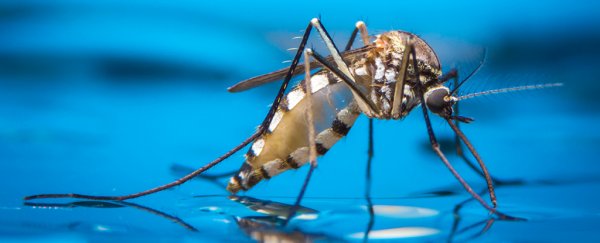Using the CRISPR/Cas9 gene-editing technique, scientists have discovered a new way to limit the spread of disease-carrying mosquitoes, which has the potential to block the transmission of diseases like Zika and malaria across whole continents.
The team's model shows that by modifying the gene coding of mosquitoes to lower fertility rates, and controlling the way those genes are passed on through generations, we could have a targeted and inexpensive way of knocking out certain species.
According to the researchers from the University of California, Berkeley, and the University of California, Riverside, what makes the approach so successful is the way in which CRISPR/Cas9 is used to make several genetic code changes at once.
"What we showed is that, if you disrupt a gene required for fertility in female mosquitoes at multiple sites all at once, it becomes much harder for the population to evolve around that disruption," says lead author John Marshall from UC Berkeley.
The proof-of-concept model developed by the team uses the idea of a gene drive – a way of pushing the spread of particular genes through inheritance down the generations, even though those genes might not support the usual 'survival of the fittest' process.
Previous studies have shown that gene drives can result in up to 99 percent of insect offspring inheriting the edited genes, but there was a problem: those who were immune to the gene drive caused a population rebound, which would make it impossible to wipe out diseases across large areas.
This is where the "multiple sites" idea makes a difference: the team used a technique called multiplexing to use guide RNAs – the targeting systems of CRISPR/Cas9 – to tweak several parts of a gene at once, reducing the chances of a rebound.
The more guide RNAs used, the greater the number of dangerous insects that can be suppressed, the researchers' model found. The study looked at fruit flies, but the team believes the approach could be just as effective for mosquitoes.
"Knowing that we can potentially overcome the issues of resistance through careful engineering and multiplexing is huge," says one of the team, Omar Akbari from UC Riverside.
If the technique can be adapted to mosquitoes and works over a large scale, the benefits could be significant. Malaria alone accounts for around 429,000 deaths every year worldwide, according to the World Health Organisation.
Before that happens, there's a lot more research to do, and a lot of regulations to navigate. Not everyone believes we should be trying to wipe out certain animal species, even if they're as dangerous to humans as the mosquito.
What the new research shows, though, is that multiplexing combined with CRISPR/Cas9 gives scientists a tool that's both very precise and capable of affecting large numbers of a species.
"The potential of multiplexing is vast," says Marshall. "With one guide RNA, we could suppress a room of mosquitoes. With four, we could potentially suppress a continent and the diseases they transmit."
"But nature has a knack for finding a way around hurdles, so assessing that potential will require a lot more work."
The research has been published in Scientific Reports.
